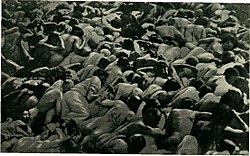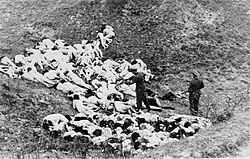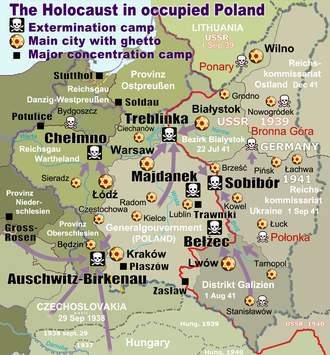ą“Ŗąµą“³ą“£ąµą“ą“æą“²ąµ ą“¹ąµą“³ąµą“ąµą“øąµą“±ąµą“±ąµ ą“¹ąµą“³ąµą“ąµą“øąµą“±ąµą“±ąµ Period September 1939 ā April 1945 Territory Occupied Poland , also present day western Ukraine and western Belarus among othersUnits SS-TotenkopfverbƤnde Einsatzgruppen Orpo battalions , Trawnikis , BKA , OUN-UPA , TDA , Ypatingasis bÅ«rys [ 1] Killed 3,000,000 Polish Jews and 2,500,000 ethnic Poles [ 2] Survivors 50,000ā120,000;[ 3] [ 4] [ 5] Jewish uprisings BÄdzin , BiaÅystok , Birkenau , CzÄstochowa , Åachwa , Åuck , MiÅsk Mazowiecki , Mizocz , PiÅsk , Poniatowa , SobibĆ³r , Sosnowiec , Treblinka , Warsaw , Wilno
ą“Ŗąµą“³ą“£ąµą“ąµ ą“ąµą““ą“ą“ąµą“ą“æą“Æ ą“Øą“¾ą“øą“æą“ąµ¼ą“®ą“Øą“æ ą“ąµą“¤ą“Ŗąµą“°ą“¶ąµą“Øą“¤ąµą“¤ą“æą“Øąµą“³ąµą“³ ą“
ą“Øąµą“¤ą“æą“®ą“Ŗą“°ą“æą“¹ą“¾ą“°ą“¤ąµą“¤ą“æą“Øąµą“±ąµ ą“ą“¾ą“ą“®ą“¾ą“Æą“æ (Endlƶsung der Judenfrage ) ą“Øą“ą“¤ąµą“¤ą“æą“Æ ą“ąµą“ąµą“ą“ąµą“ąµą“²ą“ą“³ąµą“ąµ ą“ą“±ąµą“±ą“µąµą“ ą“®ą“¾ą“°ą“ą“µąµą“ ą“
ą“µą“øą“¾ą“Øą“¤ąµą“¤ąµą“¤ąµą“®ą“¾ą“Æ ą“ą“¾ą“²ą“ą“ąµą“ą“®ą“¾ą“Æą“æą“°ąµą“Øąµą“Øąµ ą“
ą“§ą“æą“Øą“æą“µąµą“¶ą“Ŗąµą“³ą“£ąµą“ą“æąµ½ ą“Øą“ą“Øąµą“Ø ą“¹ąµą“³ąµą“ąµą“øąµą“±ąµą“±ąµ. (The Holocaust in German-occupied Poland . ą“ą“¤ą“æą“Øą“¾ą“Æą“æ ą“
ą“§ą“æą“Øą“æą“µąµą“¶ ą“Ŗąµą“³ą“£ąµą“ą“æąµ½ ą“§ą“°ą“¾ą“³ą“ ą“ąµą“ąµą“ą“ąµą“ąµą“²ą“¾āą“ąµą“Øąµą“¦ąµą“°ą“ąµą“ąµ¾ ą“
ą“µąµ¼ ą“Øą“æąµ¼ą“®ąµą“®ą“æą“ąµą“ąµ. ą“ ą“µą“ą“¶ą“¹ą“¤ąµą“Æą“Æąµą“ąµą“ąµ ą“ą“¦ąµą“Æąµą“ą“æą“ą“®ą“¾ą“Æą“æ ą“
ą“ą“ąµą“ą“¾ą“°ą“ ą“Øąµ½ą“ą“æą“Æą“¤ąµą“ ą“°ą“£ąµą“ą“¾ą“ ą“²ąµą“ą“®ą“¹ą“¾ą“Æąµą“¦ąµą“§ą“ą“¾ą“²ą“¤ąµą“¤ąµ ą“Øą“¾ą“øą“æ ą“ąµ¼ą“®ą“Øą“æą“Æą“¾ą“£ąµ . ą“¹ąµą“³ąµą“ąµą“øąµą“±ąµą“±ąµ ą“ą“Øąµą“Øąµ ą“
ą“±ą“æą“Æą“Ŗąµą“Ŗąµą“ąµą“Øąµą“Ø ą“ ą“µą“ą“¶ą“¹ą“¤ąµą“Æą“Æą“æąµ½ 30 ą“²ą“ąµą“·ą“ ą“Ŗąµą“³ą“£ąµą“ąµą“ą“¾ą“°ą“¾ą“Æ ą“ąµą“¤ą“Øąµą“®ą“¾ą“°ąµą“ ą“
ą“¤ąµą“Ŗąµą“²ąµ ą“§ą“¾ą“°ą“¾ą“³ą“ ą“Ŗąµą“³ą“£ąµą“ąµą“ą“¾ą“°ąµą“ ą“ąµ¾ą“Ŗąµą“Ŗąµą“ąµą“Øąµą“Øąµ.[ 6] ą“Ŗąµą“³ą“£ąµą“ą“æą“²ąµ ą“ąµą“¤ ą“ą“Øą“øą“ą“ąµą“Æą“Æąµą“ąµ 90 ą“¶ą“¤ą“®ą“¾ą“Øą“µąµą“ ą“ąµą“²ąµą“²ą“Ŗąµą“Ŗąµą“ąµą“ąµ.[ 7]
ą“ąµ¼ą“®ą“Øą“æą“Æąµą“ąµ ą“ą“°ą“£ą“°ą“ą“ą“ ą“®ąµą““ąµą“µąµ» ą“ ą“µą“ą“¶ą“¹ą“¤ąµą“Æą“Æąµą“ąµą“ąµ ą“ąµą“ąµą“ąµą“Øą“æą“Øąµą“Øąµ. ą“ą“ąµą“Æą“Øąµą“¤ą“°ą“®ą“Øąµą“¤ąµą“°ą“¾ą“²ą“Æą“ ą“®ąµą“¤ąµ½ ą“§ą“Øą“ą“¾ą“°ąµą“Æą“®ą“Øąµą“¤ąµą“°ą“¾ą“²ą“Æą“ ą“µą“°ąµą“Æąµą“ ą“ąµ¼ą“®ąµ» ą“µąµą“Æą“µą“øą“¾ą“Æą“¶ą“¾ą“²ą“ą“³ąµą“ ą“øąµ¼ą“ąµą“ą“¾ąµ¼ ą“ą“ą“®ą“øąµą“„ą“¤ą“Æą“æą“²ąµą“³ąµą“³ ą“¤ąµą“µą“£ąµą“ą“æą“ą“³ąµą“ ą“ą“²ąµą“²ą“¾ą“ ą“ą“¤ą“æą“Øą“¾ą“Æą“æ ą“ą“Ŗą“Æąµą“ą“æą“ąµą“ąµ.[ 8] [ 9] ą“Øą“¾ą“øą“æ ą“ąµ¼ą“®ą“Øą“æą“Æą“æą“²ąµą“Æąµą“ ą“ą“Øą“±ąµ½ ą“ą“µą“£ąµą“®ąµą“Øąµą“±ą“æą“²ąµą“Æąµą“ ą“
ą“§ą“æą“Øą“æą“µąµą“¶ą“Ŗąµą“³ą“£ąµą“ą“æą“²ąµą“Æąµą“ ą“®ą“±ąµą“±ą“æą“ą“ąµą“ą“³ą“æą“²ąµą“Æąµą“ ą“ąµą“ąµą“ą“ąµą“ąµą“²ą“ąµą“Æą“¾ą“®ąµą“Ŗąµą“ą“³ąµą“ ą“®ąµą“¤ą“¦ąµą“¹ą“ąµą“ąµ¾ ą“¦ą“¹ą“æą“Ŗąµą“Ŗą“æą“ąµą“ą“¾ą“Øąµą“³ąµą“³ ą“ąµą“³ą“ą“³ąµą“ ą“Ŗą“£ą“æą“Æą“¾ąµ» ą“ąµ¼ą“®ąµ» ą“ą“®ąµą“Ŗą“Øą“æą“ąµ¾ ą“ąµą“£ąµą“ą“±ąµą“ą“³ą“æąµ½ ą“Ŗą“ąµą“ąµą“ąµą“¤ąµą“¤ą“æą“°ąµą“Øąµą“Øąµ.[ 7] [ 10]
ą“ąµ¼ą“®ąµ» ą“
ą“§ą“æą“Øą“æą“µąµą“¶ą“ą“¾ą“²ą“ ą“®ąµą““ąµą“µąµ» ą“Ŗąµą“³ą“£ąµą“ąµą“ą“¾ą“°ą“¾ą“Æ ą“Ŗą“² ą“ąµą“°ą“æą“øąµą“¤ąµą“Æąµ» ą“ąµą“ąµą“ą“¬ą“ąµą“ą“³ąµą“ ą“¤ą“ąµą“ą“³ąµą“ąµ ą“¤ą“Øąµą“Øąµ ą“ąµą“µąµ» ą“Ŗą“£ą“Æą“ ą“µą“ąµą“ąµ ą“Øą“¾ą“øą“æą“ą“³ą“æąµ½ ą“Øą“æą“Øąµą“Øąµą“ ą“Ŗą“² ą“ąµą“¤ą“Øąµą“®ą“¾ą“°ąµą“Æąµą“ ą“øą“ą“°ą“ąµą“·ą“æą“ąµą“ą“æą“°ąµą“Øąµą“Øąµ. ą“ą“¤ąµą“°ąµą“°ą“¾ą“ąµą“Æą“ąµą“ą“¾ą“°ąµą“Æąµą“ ą“µą“ąµą“ąµ ą“Ŗąµą“³ą“£ąµą“ąµą“ą“¾ą“°ą“¾ą“£ąµ ą“ą“±ąµą“±ą“µąµą“ ą“ąµą“ąµą“¤ąµ½ ą“ąµą“¤ą“Øąµą“®ą“¾ą“°ąµ ą“¹ąµą“³ąµą“ąµą“øąµą“±ąµą“±ąµą“ą“¾ą“²ą“¤ąµą“¤ąµ ą“Øą“¾ą“øą“æą“ą“³ą“æą“²ąµą“ąµ ą“ą“Æąµą“Æą“æąµ½ ą“Øą“æą“Øąµą“Øąµą“ ą“°ą“ąµą“·ą“æą“ąµą“ą“¤ąµ.[ 3] [ 11] ą“ąµą“¤ą“°ąµ ą“°ą“ąµą“·ą“æą“ąµą“ą“µą“°ąµą“ąµ ą“Ŗą“ąµą“ą“æą“ą“Æą“æąµ½ [ 11] ą“Ŗąµą“³ą“£ąµą“ąµą“ą“¾ą“°ą“¾ą“Æ ą“ąµą“¤ą“Øąµą“®ą“¾ąµ¼ ą“°ą“£ąµą“ą“¾ą“ ą“²ąµą“ąµą“ą“®ą“¹ą“¾ą“Æąµą“¦ąµą“§ą“ą“¾ą“²ą“¤ąµą“¤ąµ ą“ąµ¼ą“®ąµ» ą“
ą“§ą“æą“Øą“æą“µąµą“¶ ą“Ŗąµą“³ą“£ąµą“ą“æąµ½ ą“Øą“æą“Øąµą“Øąµą“ ą“ą“æą““ą“ąµą“ąµą“ąµą“ąµ ą“Ŗą“²ą“¾ą“Æą“Øą“ ą“ąµą“Æąµą“¤ąµ 1939 -ąµ½ ą“±ą“·ąµą“Æ ą“ąµą““ą“ą“ąµą“ą“æą“Æ ą“Ŗąµą“³ą“£ąµą“ą“æą“Øąµą“±ąµ ą“ą“¾ą“ą“ąµą“ą“³ą“æą“²ąµą“ąµą“ąµ ą“°ą“ąµą“·ą“Ŗąµą“Ŗąµą“ąµą“ąµą“ąµą“ą“æą“²ąµą“,[ 12] [ 13] [ 14]
The Mass Extermination of Jews in German Occupied Poland (1942),[ 15] Polish government-in-exile addressed to the wartime allies of the United Nations
Bodies of Jews from the Tarnopol Voivodeship shot face down in an open pit near ZÅoczĆ³w
Entrance to Camp I at Auschwitz (top) with the sign on the gate reading Arbeit macht frei death factory nearby (bottom) at Auschwitz II-Birkenau
Liquidation of the KrakĆ³w Ghetto . Families walk to Prokocim railway station for the "resettlement". Point of destination: Auschwitz, March 1943
Jews delivered to CheÅmno death camp were forced to abandon their bundles along the way. In this photo, loading of victims sent from the ghetto in ÅĆ³dÅŗ (1942)
Auschwitz II Birkenau prisoners
Treblinka II burning during the prisoner uprising, 2 August 1943: barracks and tank of petrol set ablaze. Clandestine photograph was taken by Franciszek ZÄ
becki .
The SS Death-Head Unit from BeÅżec extermination camp , 1942
Top secret document, the so-called Hƶfle Telegram , confirms at least 101,370 train deportations of Jews to SobibĆ³r extermination camp in 1942
The original ovens inside the crematorium, on display at the Majdanek State Museum
Young Jewish insurgents captured by the SS, Warsaw .Stroop Report original caption: "HeHalutz women captured with weapons." Jewish resistance women, among them Malka Zdrojewicz (right), who survived the Majdanek extermination camp .
Children of the Warsaw Ghetto
Public execution of ethnic Poles in PrzemyÅl as punishment for helping Jews, 1943
September 1943 Żegota warning about death sentence for denunciations of Jews to the Nazis.
The burning SÅonim Ghetto during the Jewish revolt which erupted in the course of the final Ghetto extermination action. Before the joint German-Soviet invasion of Poland in 1939 SÅonim was a county seat in the NowogrĆ³dek Voivodeship . The invading Soviets annexed the city to the Byelorussian SSR in an atmosphere of terror.[ 16]
ą“
ą“²ą“æą“Æą“¾ ą“¬ąµą“±ąµą“±ąµ
Museum of the History of the Polish Jews , Warsaw, April 2013
ā "Holocaust Encyclopedia -Trawniki" . United States Holocaust Memorial Museum . Retrieved 21 July 2011 .ā Anti-Defamation League (1997). "Estimated Number of Jews Killed" . The "Final Solution" . Jewish Virtual Library. Retrieved 3 March 2015 . ā 3.0 3.1 Lukas (1989) , pp. 5, 13, 111, 201, "Introduction" . Also in: Lukas (2001) , p. 13.ā David Engel (2005), "Poland", Liberation, Reconstruction, and Flight (1944ā1947) (PDF) , The YIVO Encyclopedia of Jews in Eastern Europe , pp. 5ā6 in current document, YIVO , "The largest group of Polish-Jewish survivors spent the war years in the Soviet or Soviet-controlled territories.", ISBN 9780300119039 [see also:] Golczewski (2000) , p. 330, archived from the original (PDF) on ą“”ą“æą“øą“ą“¬ąµ¼ 3, 2013ā Cherry & Orla-Bukowska (2007) , p. 137, 'Part III Introduction' by Michael Schudrich. ā Materski, Wojciech; Szarota, Tomasz ; IPN (2009). Poland 1939-1945. Human Losses and Victims of Repression Under Two Occupations Polska 1939ā1945. Straty osobowe i ofiary represji pod dwiema okupacjami ]. Warsaw: Institute of National Remembrance (IPN). ISBN 978-83-7629-067-6 . Retrieved 2018-05-24 ā via Digital copy, Internet Archive. The 2009 study published by the IPN revised the estimated Poland's war dead at about 5.8 million Poles and Jews, including 150,000 during the Soviet occupation,[4] not including losses of Polish citizens from the Ukrainian and Belarusian ethnic groups. CS1 maint: bot: original URL status unknown (link ) ā 7.0 7.1 Berenbaum, Michael (1993). The World Must Know USHMM . Little Brown / USHMM. ISBN 978-0-316-09135-0 Archived from the original on ą“ą“ą“øąµą“±ąµą“±ąµ 22, 2016.ISBN 978-0-8018-8358-3 , p. 140.ā Aish HaTorah, Jerusalem, Holocaust: The Trains. Aish.com. Internet Archive.
ā Simone Gigliotti (2009). "Resettlement". The Train Journey: Transit, Captivity, and Witnessing in the Holocaust ISBN 1-84545-927-X ā American Jewish Committee . (2005-01-30). "Statement on Poland and the Auschwitz Commemoration." Archived ą“ą“ą“øąµą“±ąµą“±ąµ 8, 2007 at the Wayback Machine Press release.ā 11.0 11.1 Yad Vashem, The Holocaust Martyrs' and Heroes' Remembrance Authority, Righteous Among the Nations - per Country & Ethnic Origin January 1, 2009. Statistics Archived ą“ą“ą“øąµą“±ąµą“±ąµ 18, 2010 at the Wayback Machine
ā Piotrowski (1998) , Preface.ā Levin, Nora (1990). Annexed Territories ISBN 0-8147-5051-6 Many Jews associated with the Bund, Zionist organizations, religious life, and 'bourgeois' occupations, were deported in April. The third deportation in JuneāJuly 1941 consisted mainly of refugees from western and central Poland who had fled to eastern Poland.[p.347] ā Materski & Szarota (2009) , Source: Z.S. Siemaszko (pl) (1991), p. 95. ISBN 0850652103 . harvp error: no target: CITEREFMaterskiSzarota2009 (help ) ā Ministry of Foreign Affairs of the Republic of Poland (1942). The Mass Extermination of Jews in German Occupied Poland (PDF) . London, New York, Melbourne: Hutchinson & Co. Publishers: Polish government-in-exile , official report addressed to the wartime allies of the then-United Nations . pp. 1ā16 (1ā9 in current document).ā Wegner, Bernd (1997). From peace to war: Germany, Soviet Russia, and the world, 1939ā1941 ISBN 1-57181-882-0
ą“ą“¦ąµą“§ą“°ą“æą“ąµą“ą“¤ą“æąµ½ ą“Ŗą“æą““ą“µąµ: <references> ą“ą“µą“¶ąµą“Æą“¤ąµą“¤ą“æą“Øą“¾ą“Æą“æ "Berenbaum104" ą“ą“Øąµą“Ø ą“Ŗąµą“°ą“æąµ½ ą“Øą“æąµ¼āą“µą“ą“æą“ąµą“ą“Ŗąµą“Ŗąµą“ąµą“ <ref> ą“±ąµą“±ą“¾ą“ą“æą“Øąµ ą“ą“³ąµą“³ą“ą“ąµą“ą“®ąµą“Øąµą“Øąµą“®ą“æą“²ąµą“².
Arad, Yitzhak (1999) [1987]. Belzec, Sobibor, Treblinka: The Operation Reinhard Death Camps ISBN 0-253-34293-7 Baumel, Judith Tydor; Laqueur, Walter (2001). The Holocaust Encyclopedia ISBN 0-300-13811-3 Bogner, Nahum (2012). "The Convent Children. The Rescue of Jewish Children in Polish Convents During the Holocaust" (PDF) . Shoah Resource Center: 41ā 44. Archived from the original on 2012-02-17. Retrieved 2018-05-24 ā via direct download, 45.2 KB. CS1 maint: bot: original URL status unknown (link ) Browning, Christopher (2004). The Origins of the Final Solution : The Evolution of Nazi Jewish Policy, September 1939 ā March 1942 ISBN 0-8032-0392-6 Cherry, Robert D. ; Orla-Bukowska, Annamaria (2007). Rethinking Poles and Jews: Troubled Past, Brighter Future ISBN 0-7425-4666-7 Dobroszycki, Lucjan (1994). Survivors of the Holocaust in Poland: A Portrait Based on Jewish Community Records, 1944ā1947 Yivo Institute for Jewish Research, M.E. Sharpe. p. 164. ISBN 1-56324-463-2 Engel, David (1993). Facing a Holocaust: The Polish Government-in-exile and the Jews, 1943ā1945 ISBN 0-8078-2069-5 Hakohen, Devorah (2003). Immigration from Poland ISBN 0-8156-2969-9 KopĆ³wka, Edward ; Rytel-Andrianik, PaweÅ (2011). Treblinka II Death Camp. Monograph, chapt. 3 Treblinka II ā ObĆ³z zagÅady ] (PDF) (in ą“Ŗąµą“³ą“æą“·ąµ). DrohiczyÅskie Towarzystwo Naukowe [The Drohiczyn Scientific Society]. ISBN 978-83-7257-496-1 rescuers of Jews imprisoned at Treblinka I, selected testimonies, bibliography, alphabetical indexes, photographs, English language summaries, and forewords by Holocaust scholars. Archived from the original (PDF) on 2014-10-10. Retrieved 2018-05-24 ā via PDF direct download 20.2 MB.Lukas, Richard C. (1989). Out of the Inferno: Poles Remember the Holocaust University Press of Kentucky . ISBN 978-0-8131-1692-1 Lukas, Richard C. (2001). The forgotten Holocaust: the Poles under German occupation, 1939ā1944 ISBN 978-0-7818-0901-6 Materski, Wojciech; Szarota, Tomasz ; IPN (2009). Poland 1939ā1945. Casualties and the victims of repressions under the Nazi and the Soviet occupations Polska 1939ā1945. Straty osobowe i ofiary represji pod dwiema okupacjami ]. Institute of National Remembrance (IPN). Hardcover, 353 pages. ISBN 978-83-7629-067-6 Janusz Kurtyka (IPN); and expert contributions by Waldemar Grabowski, Franciszek Piper , and Andrzej Krzysztof Kunert . Archived from the original on 2012-03-31. Retrieved 2018-05-24 . CS1 maint: bot: original URL status unknown (link ) MusiaÅ, Bogdan (ed.), "Treblinka ā ein Todeslager der Aktion Reinhard", in: Aktion Reinhard ā Die Vernichtung der Juden im Generalgouvernement , OsnabrĆ¼ck 2004, pp. 257ā281.Phayer, Michael (2000). The Catholic Church and the Holocaust, 1930-1965 117ā 120, 250. ISBN 0253214718 Piotrowski, Tadeusz (1998). Poland's Holocaust: Ethnic Strife, Collaboration with Occupying Forces and Genocide in the Second Republic, 1918ā1947 McFarland & Company . ISBN 0-7864-0371-3 OCLC 37195289 .Paulsson, Gunnar S. (March 29, 2003), 'Polish Complicity In The Shoah Is A Myth' (online, Special Reports : Commentary).Paulsson, Gunnar S. (May 5, 2008), On the Marginal Role of Poles In Abetting the Nazi Perpetrators Isurvived.org
Paulsson, Gunnar S. Secret City: The Hidden Jews of Warsaw, 1940ā1945 . New Haven: Yale University Press, 2002, ISBN 978-0-300-09546-3 , Review.
Samson, Naomi (2000), Hide: A Child's View of the Holocaust. U of Nebraska Press, 194 pages.
Sterling, Eric; Roth, John K. (2005), Life in the Ghettos During the Holocaust. Syracuse University Press, 356 pages.
Schelvis, Jules (2014) [2007]. Sobibor: A History of a Nazi Death Camp ISBN 1-4725-8906-8
Camps, ghettos and operations
Camps
Mass shootings Ghettos Other atrocities
Perpetrators, participants, organizations, and collaborators
Major perpetrators
Personnel
Organizations Collaborators
Resistance: Judenrat, victims, documentation and technical
Organizations Uprisings Leaders Judenrat Victim lists
Documentation
Technical and logistics
By territory Lists and
Early elements Aftermath Remembrance



































